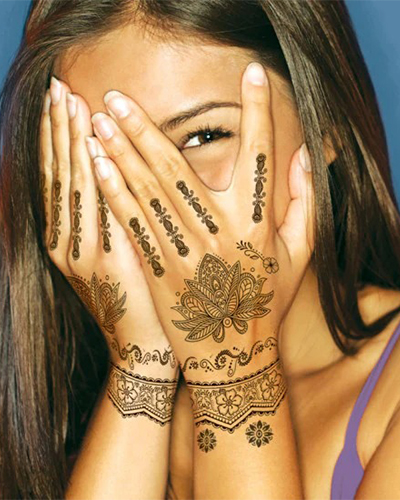

Get 10% Off Your Orders Sitewide

Asian Temporary Tattoos Starting From Only $6

Checkout Native American Temporary Tattoos Starting As Low As $6

Animal Temporary Tattoos Collection Starting From Just $6

Get Free Shipping On Orders Over $50

Signup And Get 10% Off Your First Order
“Temporary tattoos” is a term used to describe a type of body art that is temporary and can be easily applied to and removed from the skin. There is no affiliation with any particular brand or company as temporary tattoos are manufactured and sold by various manufacturers and distributors worldwide. Temporary tattoos have been used for decorative and symbolic purposes in different cultures for centuries.
The concept of temporary tattoos dates back centuries and there is evidence that they were used in ancient civilizations such as Egypt and China. These early temporary tattoos were often made using natural dyes and pigments obtained from plants or other sources.
Today, temporary tattoos are gaining popularity as a form of expression, fashion accessory, and temporary body art. They are typically made from non-toxic and skin-safe materials such as FDA-approved dyes and adhesives.
Temporary tattoos are widely available and come in a variety of forms including water transfer tattoos, adhesive tattoos, henna tattoos, and airbrush tattoos. They are available in a variety of designs, patterns and sizes to cater to different tastes and interests.
Because temporary tattoos are not affiliated with any particular brand or company, there is no single owner or founder that can be attributed to the concept as a whole. Instead, there are numerous manufacturers, retailers and online platforms that offer temporary tattoos to consumers worldwide.
Temporary tattoos are very popular among people of all ages and are widely used for special occasions, parties, festivals, as well as everyday decorations. They offer a temporary and customizable way to experiment with body art without the commitment and permanence of traditional tattoos.
It is worth noting that the temporary tattoo industry is dynamic and constantly evolving, with new designs, technologies and trends emerging over time.

Overview
Temporary tattoos are a form of body art that offers a temporary rather than permanent way to decorate the skin. They are becoming increasingly popular as a fashion accessory and a means of self-expression. Here is an overview of temporary tattoos:
Temporary Character: Unlike traditional tattoos, temporary tattoos are designed as temporary tattoos and can be easily applied to the skin and removed. They offer a temporary form of body art that allows individuals to experiment with different designs without the need for permanent tattoos or being permanent.
Different Types: Temporary tattoos come in different forms including water transfer tattoos, adhesive tattoos, henna tattoos and airbrush tattoos. Each type has its own application method and wearing time.
Designs and Patterns: Temporary tattoos come in a variety of designs, patterns, and sizes. They can contain different images, symbols, quotes or artistic patterns to cater to different tastes and interests. Temporary tattoos allow individuals to express their style, personality, or support for specific causes or fan bases.
Skin-friendly materials: Temporary tattoos are usually made from non-toxic and skin-friendly materials. They often use FDA-approved dyes, adhesives, and printing techniques to ensure they are safe to use on the skin.
Occasions and Uses: Temporary tattoos are used for various purposes and occasions. They are popular at parties, festivals, concerts, fancy dress events or simply as a fashion accessory. Temporary tattoos can be a fun and creative way to enhance a look, express individuality, or try out different tattoo designs before committing to permanent tattoos.
Accessibility: Temporary tattoos are widely available and available in retail stores, online platforms and tattoo shops. They are often affordable and easily accessible, allowing individuals to try different tattoo designs and styles without a large investment.

Highlight
Temporary tattoos are a non-permanent form of body art that can be easily applied to the skin and removed.
They come in a variety of forms, including water transfer tattoos, stick-on tattoos, henna tattoos, and airbrush tattoos, and offer flexibility in application and length of time.
Temporary tattoos come in a wide range of designs, patterns, and sizes, allowing individuals to express their style, personality, or support for a specific cause or fandom.
They are made from non-toxic and skin-friendly materials, making them safe to use on the skin and suitable for people of all ages.
Popular in various occasions like parties, festivals, concerts and as a fashion accessory, temporary tattoos offer a fun and creative way to upgrade a look or try out different tattoo designs.
They are widely accessible, available in retail stores, online platforms, and tattoo specialty stores, offering affordability and easy availability to individuals interested in temporary body art.
Water Transfer Tattoos

Water transfer temporary tattoos are among the most popular types. They usually come on a sheet with multiple designs. To apply, dampen the tattoo with water, press onto skin, then remove the backing paper, leaving the design on the skin.
Stick-on Tattoos

Stick-on temporary tattoos usually come as pre-cut designs on a sheet. They have an adhesive backing so you can peel and stick directly to skin without water.
Henna Tattoos

Temporary henna tattoos are made using a natural plant-based dye called henna. They often feature intricate designs and patterns and are applied with a paste of henna powder. Henna tattoos can last longer than other types of temporary tattoos.
Benefits of Temporary Tattoos:
Temporary and Reversible: Temporary tattoos offer an opportunity to experiment with different designs and styles without the long-term commitment of permanent tattoos. They are easy to attach and remove, allowing for variety and flexibility.
Non-Permanent: Unlike permanent tattoos, temporary tattoos do not require needles, nor do they face the potential pain and discomfort that comes with getting a tattoo.
Variety of Designs: Temporary tattoos come in a variety of designs, patterns, and styles that cater to different tastes and interests. The choice is huge, from intricate and detailed designs to simple and minimalist designs.
Safe and Non-Toxic: Temporary tattoos are generally made from non-toxic, skin-safe materials, making them suitable for people of all ages. They undergo testing to ensure they meet safety standards.
Ease of Application: Applying temporary tattoos is typically a straightforward process that often involves water transfer, tap-on, or airbrush techniques. They can be easily applied at home without the need for professional help.
Disadvantages of Temporary Tattoos:
Short Duration: Temporary tattoos are designed to be temporary tattoos and their longevity may vary based on factors such as placement, skin type, and maintenance. They may not last as long as permanent tattoos and will need to be reapplied more often to achieve the desired look.
Limited Realism: While temporary tattoos come in a variety of designs, they may not achieve the same level of detail, texture, and realism as permanent tattoos. This limitation may affect the desired aesthetics for some individuals.
Hypersensitivity or Allergic Reactions: While most temporary tattoos are made from non-toxic materials, some individuals may experience hypersensitivity or allergic reactions to the adhesive or dyes used. It’s important to test a small area of skin before applying a temporary tattoo if you have known skin sensitivities.
Design Limitations: Temporary tattoos may have size limitations and are generally restricted to flat areas of the body. Intricate and detailed designs can be difficult to accurately recreate with temporary tattoos.
Environmental Impact: Some temporary tattoos are made from materials that are not biodegradable and may contribute to environmental pollution when disposed of.
Conclusion
Temporary tattoos offer a temporary and reversible form of body art, allowing individuals to experiment with different designs and styles without having to deal with permanent tattoos. They come in a variety of styles, are generally safe and non-toxic, and are easy to attach and remove.
However, temporary tattoos have limitations such as: B. their short duration and possible lack of realism compared to permanent tattoos. Some individuals may experience sensitivities or allergic reactions to the materials used, and there may be design constraints and environmental considerations.
